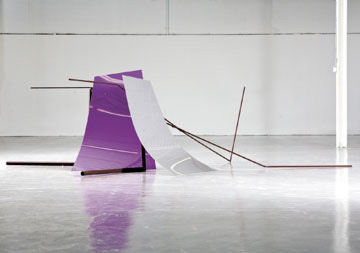
 Sculpture News at SculptSite.com
Sculpture News at SculptSite.com
Tim Scott |
| Written by Carl Mellor - Mar. 3, 2010 08:29 AM Syracuse New York Times Hue and Cry Sculptures made large and small comprise Tim Scott - The Sixties: When Colour Was Sculpture, on display through April 11 at the Everson Museum of Art, 401 Harrison St. The exhibit presents both six large-scale pieces created during the 1960s and several much smaller sculptures from Scott's "House of Clay" series, a body of work begun just a few years ago. Scott's large pieces show him to be comfortable in multiple roles: as a sculptor with an innovative approach to the medium, as a builder with a poet's sensibility, and as an artist proficient in design and execution. He combines metal tubes and rods with acrylic sheets, creating designs with a practical bent. Scott uses nuts and bolts, screws, bars and other devices to hold together sculptures so large they are rarely exhibited. At the same time, the work isn't intended to merely evoke beams or building techniques. Scott's acrylic sheets offer colors ranging from ultra-bright orange to fuchsia, from radiant red to gray and brown. In addition, he paints many of the rods and tubes in subdued colors. The sculptor is subtle in his choice of forms, disciplined in his construction of the sculptures and direct in his presentation of color. "Bird in Arras VII," with its mix of intense orange and yellow colors, simply lights up the museum's first floor. It's part of a sextet, a group of six sculptures each noteworthy in itself. Interplay between colors is only one of Scott's strategies for exploring various hues. In several of the sculptures, metal components back up, hold up or support acrylics. In "Bird in Arras III," a long bar extends behind the sheets and is intersected by five tubes. And in "Bird in Arras VII," steel tubes link acrylic sheets, each with a rectangular shape. Other motifs emerge as well. In some of the pieces, tubes intersect, enclose or even pierce colors. In "Sestina," a standout within the show, tubes provide an underpinning for sheets and objects made from metal. A purple sheet extends away from the sculpture, and it's easy to fantasize the sheet trying to escape yet unable to do so. Even more importantly, Scott is able to play with large-size sculptures and convey a sense of flow or movement. "Quinquereme," an extremely long work of art, brings to mind a ship gliding on the sea; the sculpture seems to move through the gallery. "Bird in Arras III" takes on different guises depending on the viewer's position. From one angle, it looks ready to tip over while from another side it appears solidly constructed. From a third angle, there's an illusion of acrylic sheets sliding up and down the bar that anchors the sculpture. Scott's clay sculptures, made four decades after he created the large works, document his latest project, reminding viewers that his work continues to evolve. Only a small selection of the stoneware sculptures is on display, but that's hardly surprising: the exhibit intends to showcase the larger works. On that count, it does very well. Meanwhile, Jen Pepper's site-specific installation, that which cannot be held, has taken over the Robineau Gallery. Viewers will encounter a curtain of finely crocheted wire, flowers painted white, a mass of cable unbound and unruly, and, on the far wall, video images of Chittenango Falls in the midst of a winter thaw. On one level, the installation creates an unsettling environment full of light and shadow, where everything is in flux. On another, it raises questions about order and chaos, our ability to recognize and adapt to change, our emotional response to new situations. Among other things, the installation challenges viewers to think about more than day-to-day considerations. Pepper's work, which runs through April 4, is a fine kickoff for "The Edge of Art," a brand-new Everson Museum series. Its exhibits will feature contemporary works by artists living in New York state. The Everson is open Tuesdays to Fridays and Sundays, noon to 5 p.m., and Saturdays, 10 a.m. to 5 p.m. For more information, call 474-6064. |
 "Wine" Tim Scott |
More Sculpture News ....
Submit your SCULPTURE NEWS.
It's easy, just send us an e-mail
(click on Submit News in the left menu) with your pertinent information along with images, we'll take care of the rest. Sculpture makes our world a much better place in so many ways!
SculptSite.com, along with Sculptors and their creative genius all helping to bring the beauty and message of Sculpture to a hurried world.

